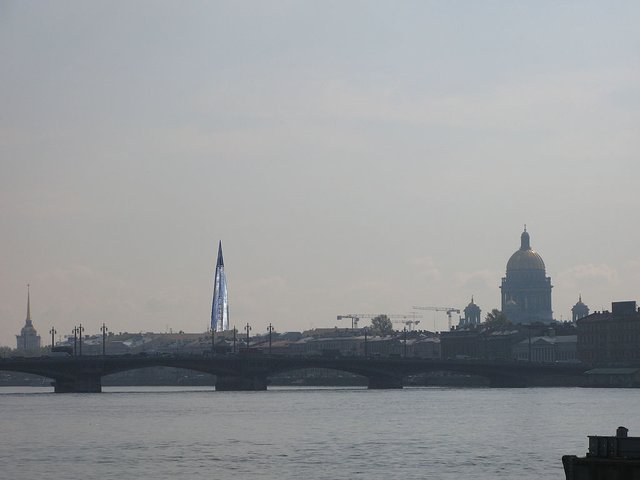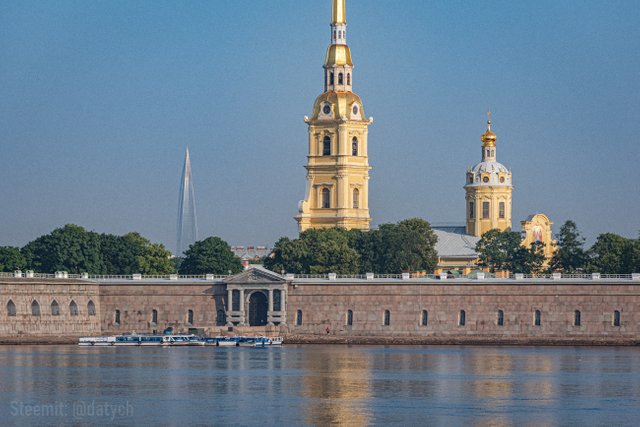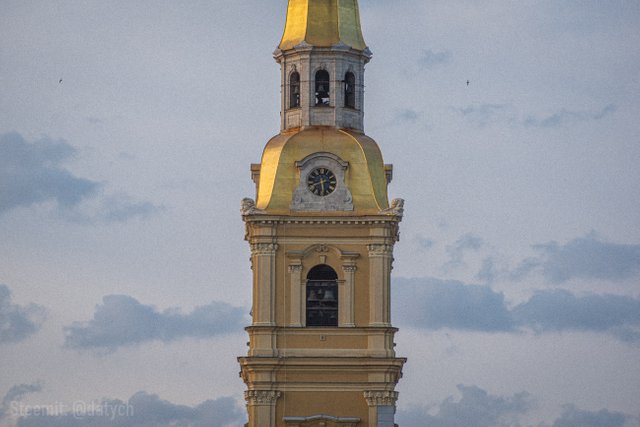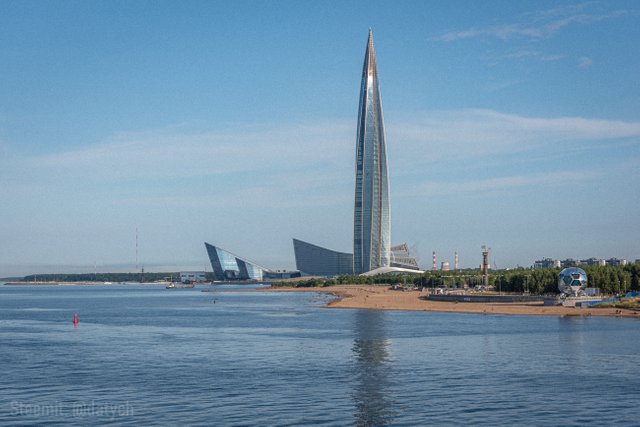Corn Penetration. How Corporation Damages a UNESCO Heritage City
In the photo, Peter and Paul fortress and Lakhta Center, nicknamed the Corn, the tallest skyscraper in Europe
Since the very foundation in 1703, Saint Petersburg had been built according to urban development plans aimed to ensure "order and splendour".
You couldn't build whatever you wanted - architects working for police granted permissions and even provided drawings of allowed designs of houses.
In 1844, the city adopted rules saying that buildings, except temples, must not exceed 23.5 metres in height. The main reason was aesthetics. To that time, Saint Petersburg was one of the most attractive and advanced capitals in Europe.
Bell tower of Saints Peter and Paul Cathedral. 122.5 metres in height, a temple-skyscraper of the XVIII century. More picture of the fortress in my previous story
After the October Revolution, Communist authorities kept the tradition preserving the look of the old city.
However, in 2008, high-rise construction regulations were cancelled to please a gas corporation Gazprom with its intention to erect a skyscraper.
Collages showing the result were shocking:

source
The public was opposing, many were outraged. UNESCO got interested in the case. Protests and lawsuits have attracted the attention of the Kremlin.
As the result, Gazprom moved the construction site further away from the historical part of the city so the worst expectations didn't come true.
Nevertheless, the 462-metre Corn has become a part of the old city's skyline as it is shown in the first image.
Lakhta Center in 2021
Meanwhile, the gas monster cannot calm down and longs for new towers. Gazprom has suggested raising another skyscraper, 703-metre high this time, next to Lakhta Center.
The "icicle" ("сосуля") might appear behind the classical outlines of Peter and Paul fortress, much higher than its older glass fellow (watch in the video).
All images (except the collage) were taken by me in July 2021 with a Nikon D750 + a Nikkor 70-300mm telelens.
The bell tower clock will join Cityscape Photo / Art Contest by @axeman in World of Xpilar Community.



You post is nominated for „Wold of xpilar“ Community Support Program, @booming account upvote. Only the posts that are not cross posted, original and posted from community page are eligible. If your post gets approval, then you get upvote within few days. Good luck!
I got it ) Thank you!
Habana Libre Hotel is the tallest building in Cuba which rises only 126 meters, which makes the Corn 3.7 times taller.
Tall buildings are cool. But eroding things that were done with much work and dedication is wrong. I hope Habana Libre Hotel is cute and stands at the right place.
At least it was built in a modern area.
I think that both of the new buildings are beautiful and can fit into the Saint Petersburg skyline. The trick, I think, is to be able to honour both new and old architecture. If the new buildings are of a quality that is meant to last forever---rather than the disposable type of buildings that seem to be built these days-- then I believe that the new additions reveal that Saint Petersburg remains a living, functioning city that transcends centuries of social change and political upheaval.
Perhaps what is important is to ensure that the new buildings do not block the heritage buildings from view of the sea. If I was in charge of things, I would make sure that any new buildings came with the price of the developer setting aside funding for the maintenance and repairs of the heritage buildings.
Many people think in the same way. And I understand it.
Still, I believe the modern times are not about half-kilometre tall buildings only. Here, there are many beautiful modern buildings, large bridges, there are reclaiming territories from the sea, etc. But no reason to build the tallest buildings in Europe in the least appropriate place, the UNESCO city where the skyline is a part of historical heritage.
I described how they cared about the look of the historical part of the city. It is not just an old city without tall buildings in the historical part because the city is old. They could construct tall buildings in XIX-XX cc., but they cared about the architectural harmony. Without this aesthetic attitude (shared by many regular townspeople today too), unique for disorderly Russia, we would live in another ugly post-Soviet city.
Are post-Soviet cities ugly?
Yes, you have a good point. The buildings do not have to be so ridiculously tall. It is kind of funny how tall buildings have always been a project of rich industrialists. Are they symbolic of something?
This is a symbol of exorbitant ambition and disregard for traditions ... увы
I was thinking more about some small body part they are sad about. :-p
Simply, there are some "small pieces" that are particularly dear :-)
Simply, there are some "small pieces" that are particularly dear :-)
Are post-Soviet cities ugly?
Too many of them.
But WHY are they ugly? I am curious. I know that brutalist Soviet architecture is considered ugly, but what is happening in the post Soviet era that makes everything ugly?
Generally, as I see, you can say the city is nice in the ex-Soviet space when it has a good historical part, core, city centre. This is how many people see things in Russia, for example. Not many ex-Soviet cities have old blocks.
Mostly because these cities appeared or grew large during urbanisation in 1960-1980. Too many old unattractive apartment buildings there.
From Russian wiki, google translated:
Most Russian cities appeared in this grey time. Of course, Soviet capitals and several major cities like Leningrad had some space for experiments with arcihtectural styles and there are samples of very interesting Soviet archirecture, etc.
New construction in 1990-2020s didn't always make a city nice, mostly not. Many people say that Moscow lost much of its charm, old districts, due to uncontrolled contruction.
And not possible to talk about all cities together, every place has its own situation.
Actually, this is a large topic about history, mentality, politics.
What I get from this is that the architecture of Imperial Russia was wonderful, but the Soviet era was bad and the post Soviet era is even worse.
I would argue that unbridled capitalism does NOT lend itself to the beautification of public spaces or to the quality of architecture. Western architecture since the 1980s has declined terribly---actually all production has declined.
Housing and commercial buildings are made of the cheapest materials and are not built to last more than a couple of decades. Houses are built on increasingly small lots and lately the lots are so small that it is impossible to plant a tree on them. Yet, these new subdivisions are surrounded by open fields waiting for future development. There is no reason that the building lots are so small--except for profits. It used to be the norm for each house to be built on a 60X120 foot lot. Plenty of room for the dwelling, a vegetable garden, trees for shade, a place to park the car, room for children to play... . Now the norm seems to be a 30X30 foot lot. Just enough to accommodate the footprint of the house itself. These neighbourhoods soon turn into slums because the homes are too close together and the streets are filled with cars.
https://www.austinmonitor.com/stories/2019/02/city-has-tough-decisions-on-affordable-housing-bond/
A neighbourhood like this has up to 4 dwellings per building. These are duplexes and each side likely has a basement suite for the homeowner to rent out. No trees for cover, nowhere to accommodate vehicles, nowhere to grow a few vegetables for food, nowhere for kids to play.
I didn't say that you did! That was me adding the component of ideology to the discussion. :-D Unfortunately, it is difficult to completely divorce ideology from the art and technology that humans produce. The function of the objects we create is shaped by our values.
That neo classical subway station is interesting. On one hand it is derivative as all "neo" types of architecture are, but on the other hand it is built of quality materials meant to last AND will continue to be beautiful no matter how old it gets. I will take that over particle board flooring any day.
It is not whether capitalism is good or bad--or if capitalism is more or less authoritarian than communism. It is just simply fact that architecture is on the decline in countries with advanced capitalism. Not in decline based on style--but based on the materials used and the longevity of the structure. Our objects are becoming less functional.
I personally appreciate brutalist architecture, even the soul destroying uber-bureaucratic style of administrative buildings that some people complain about. Give me a huge block of unadorned concrete in exchange for a building that will crumble within a single generation.
some examples of brutalism
Even an abandoned building, as long as it is of quality construction, can be refurbished and brought back into use.
These days, they build endless strip malls that are constructed of steel studs on a concrete slab. The studs are then clad with plywood which is then finished with some stucco and decorative veneer masonry. It is sort of like the old west where a primitive log building was covered in a fancy facade--only in this case the log building is superior to what they are using now.
The inside is finished to the specifications of the tenants. Needless to say, these structures are not built to last or to withstand extreme weather events. In a sense, they are temporary structures and meant to be that way.
Амбициозные дебилы... или словами Лаврова, ДБ...
куда пропал наш кубинский друг?
куда пропал наш кубинский друг?
Сейчас постучу в стену.
...
Сейчас такое время, что не трудно пропасть. "Война, эпидемия, снежный буран, космоса черные дыры", как поется в песне.
Не знаю...
Просто он зря простаиваетЮ мог бы уже жирка прикопить за время простоя. Посты то у него годные :)
Нет ли на примете ещё подобного героя?
Это верно )
Да особо что-то не видно пока. Если найду - сообщу )
пропал парень, жаль
Жаль. Думаю, что-то случилось - надеюсь, завал по работе, а не что-то драматичное. Потому что он был серьезно мотивирован. Надеюсь, вернётся.
Да, жаль, всё щло хорошо и резкое молчание. Главное, чтобы был здоров, хороший парень.